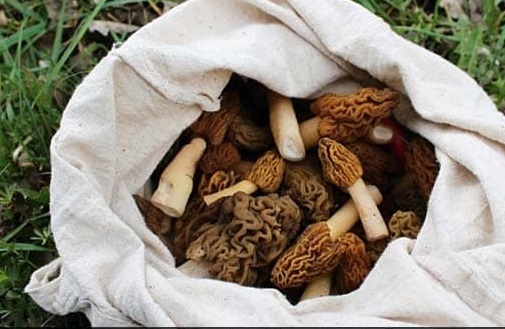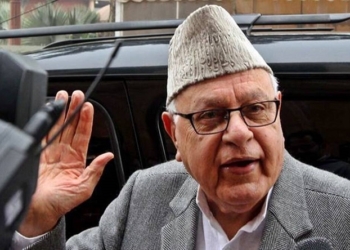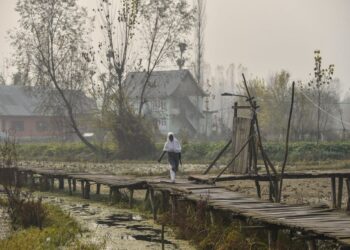
There is an “intense competition” for mushroom gathering, especially for the morels because of their high commercial value.
A substitute of meat with high nutritious and medicinal value, the morel mushroom, locally known as ‘Kanegeich’ in Kashmir is the world’s costliest mushroom.
Kashmir lies in the north-west Himalaya range that has a rich repository of unexplored macrofungal wealth. The geographic conditions in Kashmir provide a befitting environment for the growth of this heterogeneous group of fungi.
Morel mushrooms commonly known as Gucchi in India belongs to the Morchella family that grows in a diverse range of habitats such as coniferous forests, deciduous forests, alpine and subalpine pastures. These macrofungal species are found in the foothills of Uttarakhand, Himachal Pradesh, and Jammu & Kashmir.
Gucchis are characterized by their honeycomb heads and the appearance can vary from oblong to bulbous. Morels are not farmed but they are found in the forest located 2000 meters above sea level. High-altitude areas in Kashmir like Kangan, Anantnag and Kupwara are ideal for their growth. The morel collection is more frequent during March and April and July and August.
A study done by Sanjeev Kumar and Yash Sharma from the Department of Botany, University of Jammu, finds out that collection of the wild mushrooms in Kashmir is done early in the morning. There is an “intense competition” for mushroom gathering, especially for the morels because of their high commercial value. Women are always accompanied by children for morel collection because children’s sharp eyes and proximity to the ground help them in locating the morels easily, the study mentions.
Since Gucchis are sold at Rs 10,000 to Rs 30,000 per kilogram in the market, a majority of the rural people in the valley participate in morel collection besides practicing agriculture and herding, Kumar and Sharma state in their study. With open and unrestricted entrance to the forests and grasslands, and no expenditure involved for mushroom gathering, morel collection is a chief occupation for rural people.
While most of the wild mushrooms are consumed in fresh forms, the Morchella family mushrooms are preserved after sun drying, smoke drying or salting. The morels are then packed in gunny bags or jars for selling in the market.
Morels are usually cooked with tomatoes and onions in the valley. “The dried ones are consumed in off-season particularly during winter months during which the availability of vegetables is scarce in the hilly inhabitations and the movement of the local people is restricted due to snowfall and harsh weather,” the study mentions.
Gucchis are used for making traditional Kashmiri delicacies like ‘Chaschni’ (a local dessert), ‘Thunthoo Pullow’, (rice and morels), ‘Thunthoo Kheer’ (milk and morels), and ‘Thunthoo Yakhni’ (curd and morels), Kumar and Sharma note.
Another study on trade of morels in Jammu & Kashmir by Sanjeev Kumar and YP Sharma, Department of Botany, University of Jammu, points out that morels are one of the most important sources of income for rural and tribal people who are involved in the collection of the fungi.
Due to its profitability, almost all members of the families are actively involved in morel collection. Dried morels are exported from India to international markets and the state of Himachal Pradesh ranks first in the trade followed by Jammu & Kashmir.
Apart from economic benefits morels are also used for medicinal purposes. It is rich in iron, carbohydrates, proteins, fiber, vitamin B and vitamin D. It has antitumor, antimicrobial, anti-inflammatory and antioxidant properties. It also helps to build immunity and prevent heart and liver diseases.
Morels constitute the most savored food commodities amongst the number of non-conventional food items primarily because of their unique flavor and texture. With growing urbanization and habitat destruction the morel vegetation is decreasing in Kashmir. Since it cannot be cultivated commercially, it is very important to prevent the encroachment of forest to protect the fungi.
Follow this link to join our WhatsApp group: Join Now
Be Part of Quality Journalism |
Quality journalism takes a lot of time, money and hard work to produce and despite all the hardships we still do it. Our reporters and editors are working overtime in Kashmir and beyond to cover what you care about, break big stories, and expose injustices that can change lives. Today more people are reading Kashmir Observer than ever, but only a handful are paying while advertising revenues are falling fast. |
| ACT NOW |
| MONTHLY | Rs 100 | |
| YEARLY | Rs 1000 | |
| LIFETIME | Rs 10000 | |










